Marvel Rivals Hero Tier List Competitive – Best Picks & Meta Guide
Updated On: November 12, 2025 by Aaron Connolly
Competitive Marvel Rivals Tier List Overview
You’ll find that data-driven tier lists rank heroes by win rates, pick rates, and performance metrics from all competitive skill levels. Right now, the current meta really rewards team coordination and objective control, so some heroes just feel way more important in ranked matches than in casual play.
How the Tier List Is Ranked
We build competitive tier rankings from measurable performance data, not just gut feelings or personal favorites. Win rates stand out as the main metric, showing how often teams win with certain heroes across thousands of games.
Pick rates tell us which heroes players love to use in ranked. When a hero combines strong win rates with high pick rates, you know they’re a real powerhouse and not just a niche choice.
Key ranking factors:
- Win percentage in competitive matches
- Pick frequency at all skill levels
- Team synergy potential
- Counter-play resistance
We weigh performance data differently depending on rank. Heroes who perform at high skill tiers get more weight since competitive play favors mechanical skill and strategy.
We update these rankings as balance patches shake things up. Storm’s recent buffs shot her up to S-tier with a 56% win rate, while others fell after nerfs knocked them down a peg.
Importance of the Current Meta
Season 3.5’s meta puts a spotlight on heroes who thrive in team fights and control objectives. Long, drawn-out battles favor those with steady damage and reliable healing, not just bursty picks.
Meta-defining elements:
- Longer team fights
- Objective-focused gameplay
- Big value on crowd control
- Strong team synergies
Luna Snow stands out—her healing keeps teams alive during those marathon skirmishes. Her Fate of Both Worlds ultimate heals 250 health per second, which can carry a team through tough objective pushes.
Storm’s weather powers fit perfectly here. She switches stances for damage buffs (16% for herself, 8% for the team) or speed boosts, which really helps with fast repositioning and objective play.
Team composition actually matters more than individual skill right now. Heroes with strong synergy shoot up the rankings because well-coordinated teams almost always beat solo standouts.
What Competitive Play Means in Marvel Rivals
Competitive play means ranked matches where you face skill-matched opponents and teamwork really matters. It’s a whole different vibe than quick play, where solo plays can sometimes overshadow team effort.
Ranked play rewards heroes who perform well across all skill levels. Doctor Strange keeps his spot near the top because his defensive skills and team mobility work even if your squad isn’t perfectly coordinated.
Competitive advantages:
- Reliable performance across skill ranges
- Good synergy with teammates
- Solid counter-play options
- Objective control
Some heroes need a lot of mechanical skill, so they don’t always rank as high despite their potential. Iron Man, for example, needs great positioning and timing, making him less consistent for most players than someone like Hulk.
We focus on heroes that help teams win, not just those who rack up flashy stats. Mantis ranks high since her healing and crowd control help the team win, even if her damage isn’t top-tier.
Top-Tier Heroes for Competitive Play
The S-tier heroes stand out with win rates above 55%. A-tier picks still perform well but usually need a bit more skill. After recent balance changes, Storm and Doctor Strange climbed to the top, and team synergy feels more important than ever.
S-Tier Heroes and Their Unique Strengths
Storm leads the charge with a 56% win rate in competitive games. Her Weather Control lets her flip between Thunder Mode (16% damage boost) and Tornado Mode (16% speed boost), so she’s flexible in almost any situation.
She gives the whole team 8% damage or speed buffs, depending on her mode. That flexibility is just so good for both pushing hard and pulling back when needed.
Doctor Strange stays S-tier with his battlefield control. His Shield of the Seraphim protects squads during tough fights, and Pentagram of Farallah helps teams move fast for objectives.
When he teams up with Hulk, they unlock Gamma Charge, which gives 150 extra health and boosts his Maelstrom of Madness. That combo is everywhere in top-level play.
Luna Snow rounds out S-tier thanks to her dual threat. Her Light & Dark Ice weapon deals 20 damage and heals allies for 20 health per round. Her Fate of Both Worlds ultimate heals 250 per second or can boost team damage by 40%.
| Hero | Win Rate | Key Strength | Best Team Role |
|---|---|---|---|
| Storm | 56% | Weather buffs | Damage/Support |
| Doctor Strange | 54% | Battlefield control | Tank/Utility |
| Luna Snow | 53% | Damage/Healing | Support/DPS |
Notable A-Tier Contenders
Iron Man sits strong with 50-60% win rates across ranks. His aerial mobility and Repulsor Blast make him deadly if you’ve got the skills. The Gamma Overdrive combo with Hulk really amps up his damage.
He’s picked a lot for his versatility, but you have to position well, and counters like Hawkeye and Hela can shut him down fast.
Magneto brings 650 HP and awesome crowd control with Metallic Curtain and Metal Bulwark. His Iron Bind can lock down targets and dish out steady damage.
Scarlet Witch also deserves a mention for her Reality Warp and Mystic Protection. She can deal huge damage if she’s positioned well, but her 250 HP makes her fragile.
These heroes need more mechanical skill and teamwork than S-tier picks. Their ceiling is high, but they’re just a bit less consistent across all skill levels.
Recent Changes Shaping Rankings
Season 3.5’s updates made Storm way tougher. Her Omega Hurricane now gives 450 bonus health, up from 350, and her win rate jumped from 47% in Quick Play to 56% in ranked.
Doctor Strange got better with improved team-up abilities. The Gamma Charge synergy with Hulk is almost unstoppable in coordinated play.
The meta now favors objective control over just racking up kills. Heroes like Luna Snow and Mantis climbed the rankings because they stick around in team fights. Pure damage dealers aren’t as popular right now.
New heroes like Mister Fantastic and Invisible Woman are shaking up team comps. Early stats show they counter several A-tier picks, so rankings might shift again soon.
Balance patches keep targeting solo-carry heroes and boosting team-focused abilities. That’s great news for heroes with built-in synergy and support skills.
Role Breakdown: Vanguards, Duelists, and Strategists
Marvel Rivals splits all 33 heroes into three main roles, and these roles shape every competitive team composition. The best heroes in each role really shine at their main job, but also offer unique skills that create awesome team synergies in higher-ranked matches.
Best Vanguards for Competitive Play
Vanguards act as the frontline tanks, soaking up damage and making space for their team. The top Vanguards have big health pools and strong crowd control.
Hulk leads S-tier for a reason. His huge health and leap let him start team fights and mess up enemy formations, drawing fire away from his teammates.
Doctor Strange plays a bit differently as a tank. His portals move the team around quickly, and his shields keep key allies safe in clutch moments.
The best Vanguards usually:
- Survive under pressure
- Have good tools to start fights
- Bring crowd control
- Create space for damage dealers
Most teams pick one Vanguard as the main tank. It takes good positioning and awareness to play this role well at high ranks.
Elite Duelist Choices
Duelists dish out most of the damage in competitive Marvel Rivals. The best ones combine steady damage with ways to escape or heal themselves.
Wolverine is a beast in close-range fights, and his healing keeps him alive during long brawls. His mobility makes him a real threat to enemy Strategists.
Elite Duelists usually fall into two groups:
- Flankers: High mobility, go after the backline
- Sustained DPS: Steady damage from safer spots
Teams often run two Duelists to keep up the damage. The best players pick heroes that can handle anything the match throws at them.
Pairing a flanker with a steady damage dealer keeps the enemy guessing and splits their focus.
Top Strategists for Team Support
Strategists handle healing, buffs, and utility to keep teams alive in heavy fights. The strongest ones offer reliable healing and extra team benefits.
Luna Snow stands out with her healing and crowd control. Her ultimate can completely flip a team fight.
Mantis brings steady healing and sleep abilities that can take key enemies out of the fight. She fits well in lots of team comps.
Top Strategists usually have:
- Reliable healing
- Positioning tools
- Extra utility, not just healing
- Strong ultimates
Most teams run at least one Strategist for team fights, sometimes two for more survivability in aggressive lineups.
Key Factors Influencing Hero Rankings
Several data-driven factors decide where heroes land on Marvel Rivals tier lists. Patch changes, statistical performance from competitive games, and hero difficulty all play big roles.
Impact of Patch Updates on the Meta
Patch updates can flip the competitive scene overnight. Hulk shot up to S-Tier after big buffs, while Human Torch struggled even as a new release.
The three-healer meta popped up after balance changes made support heroes more viable. Storm became relevant after her Wind Blade rework boosted her damage and ally buffs.
Balance changes usually affect:
- Damage and survivability
- Ability cooldowns and costs
- Team-Up synergies
- Ultimate power
We see heroes like Wolverine get popular right after buffs, while old favorites can drop off after nerfs. The Thing made a splash as a tank right away, showing how new releases can shake up team strategies.
Players need to stay flexible. What worked last season could flop after a big patch.
Role of Win Rates, Pick Rates, and Ban Rates
Statistical data forms the backbone of tier rankings. Win rate shows how often teams win with certain heroes, while pick rate reveals who players trust in ranked.
Ban rate matters a lot in Diamond+ games, where bans shape team comps. High ban rates usually mean a hero is just too strong or disruptive to ignore.
| Metric | What It Shows | Impact on Rankings |
|---|---|---|
| Win Rate | Success percentage | Core tier placement |
| Pick Rate | Player confidence | Meta popularity |
| Ban Rate | Perceived threat level | Competitive viability |
Data shows different trends at different ranks. Heroes perform one way in “ban ranks” and another below Diamond. Spider-Man is a good example—he looks a lot stronger when opponents can’t ban his counters or prep specific strats.
We dig through thousands of match histories to find the heroes who perform well consistently—not just in a few lucky matches.
Skill Ceiling and Accessibility
Skill ceiling can really shake up hero rankings, since not everyone taps into a character’s full potential. Magneto’s a perfect example—his tricky resource management slips under the radar, even though he’s got insane theoretical power.
Beginner-friendly heroes like Iron Man, Mantis, and The Punisher tend to rank high for new players. Their abilities are simple, so you get value right away, no mechanical wizardry required.
Expert-level heroes such as Thor, Spider-Man, and Storm take a lot of practice, but if you put in the time, they can completely change the game. Their tier spots show off what top players can pull off, not just the average outcome.
Accessibility really explains why some heroes land in different tiers depending on your rank. A hero might wreck in Celestial/Top 500 play but fall flat in lower ranks, where players can’t pull off complex combos or tricky movement.
We look at both how well a hero works for casual players and how high their ceiling goes for top teams when we rank them.
Team Composition and Synergy in Competitive Matches
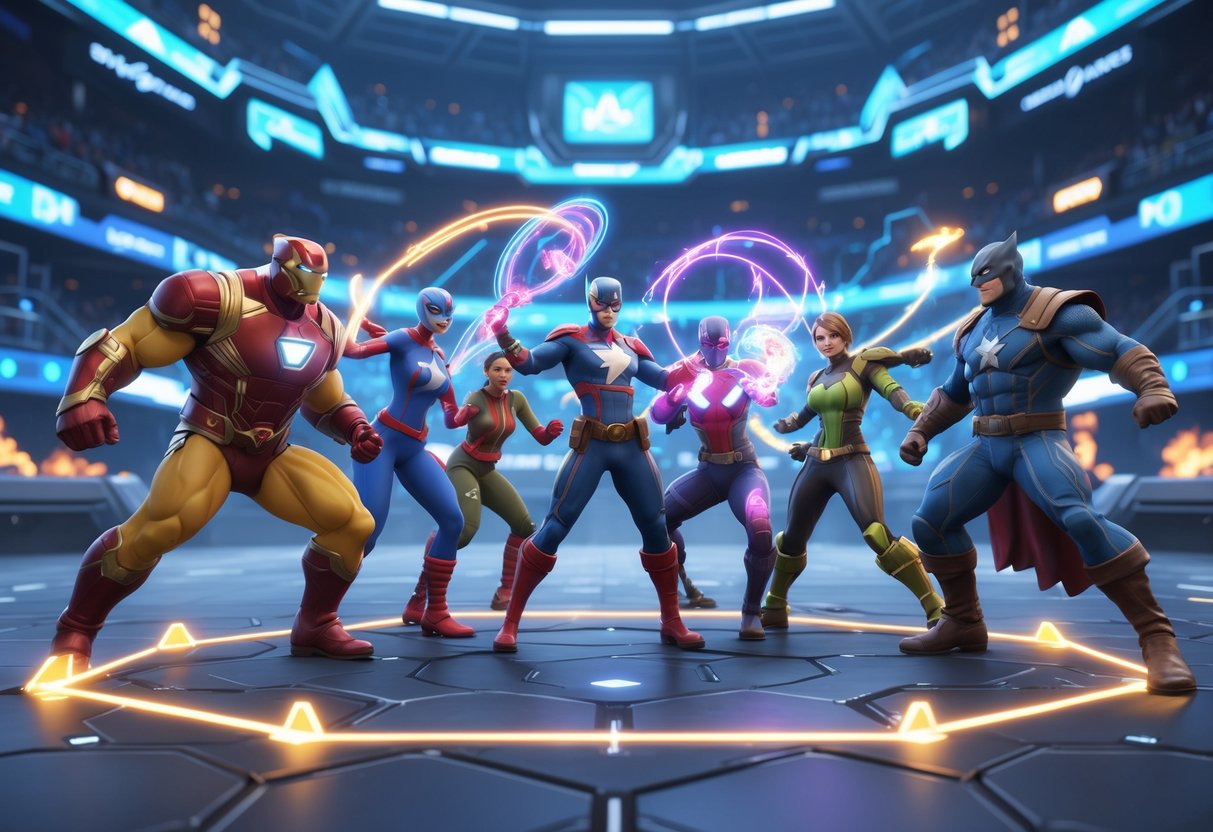
Winning in Marvel Rivals really comes down to building balanced teams with strong hero synergy and team-ups. The best squads mix crowd control, burst damage, and smart positioning to take over matches.
Building Effective Team Compositions
Competitive teams need to juggle three main roles. Each lineup should include Vanguards (tanks), Strategists (support), and Duelists (damage dealers) in the right mix.
The 2-2-2 Standard
Most top teams run two heroes from each role. That gives you a steady frontline, healing, and enough damage to stay dangerous.
Triple Strategist Compositions
Sometimes, teams stack three Strategists, especially with hybrids like Ultron. Triple strategists give you tons of sustain, but you’ve got to position carefully.
Popular meta lineups include:
- Dive Comp: Captain America, Magik, Black Panther with Mantis on support
- Flying Comp: Storm, Iron Man, and Emma Frost for protection
- Defensive Hold: Peni Parker, Rocket Raccoon, plus area denial
Map layout matters a lot. Dive teams thrive in enclosed maps, while open maps let flying heroes shine.
Countering Enemy Compositions
Emma Frost shuts down dive teams. Magneto messes with flying comps. Spotting enemy patterns early lets you swap heroes and turn the tables.
Synergy Between Heroes and Team-Ups
Team-ups can totally change a match. The Guardian Revival combo with Mantis and Star-Lord doesn’t get enough love, even though the stats back it up.
High-Impact Team-Ups
- Ragnarok Rebirth (Thor + Hela): 22% win rate boost
- Stark Protocol (Iron Man + Ultron): 17% more wins
- Rocket-Peni Partnership: Amazing area control
The best team-ups build on what heroes already do well. Rocket Raccoon’s tricks mesh perfectly with Peni Parker’s defensive play.
Building Around Team-Ups
Teams often build their whole comp around a strong team-up. Luna Snow and Hawkeye, for example, look promising in the current meta.
Synergy Metrics Matter
Heroes with high synergy scores just win more in coordinated play. Mantis, Rocket Raccoon, and Thor really pop when you team them up, compared to just running them solo.
The Importance of Crowd Control and Burst Damage
Crowd control and burst damage combos decide who wins fights in Marvel Rivals. You need both to finish off targets and lock down objectives.
Crowd Control Priorities
Storm’s weather shuts down areas. Magneto can toss enemies around, breaking their formation. Crowd control sets up your damage dealers for easy picks.
Burst Damage Windows
Magik melts isolated Strategists with her burst. When Duelists line up their attacks, they can blow through enemy healing.
Timing Combinations
The best teams line up crowd control and burst at the right moment. Emma Frost’s defenses let your damage dealers go all-in safely.
Target Priority Systems
Go for Strategists first, then pick off lone Duelists. Leave Vanguards for last, unless they’re way out of position.
By mixing displacement and focused fire, teams can rack up eliminations reliably.
Standout Individual Heroes in the Meta
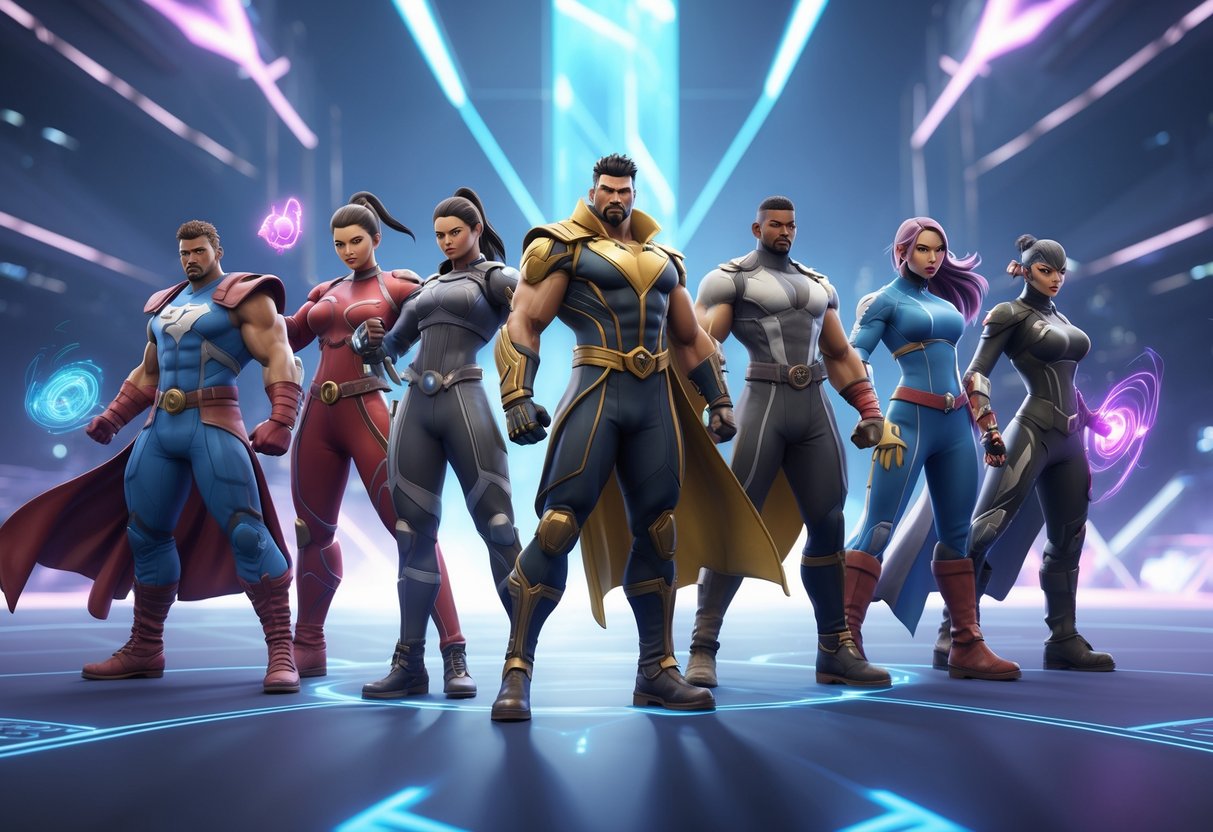
Some heroes just stand out in Marvel Rivals, taking over games almost by themselves. The top solo carries pump out raw damage, while support heroes hold teams together with clutch plays.
Strong Solo Carries and Duelists
Magik really leads the pack as the go-to dive assassin this season. Her burst damage lets skilled players snipe enemy strategists and vanish before anyone can react.
She slips past frontlines with ease. Sure, she has a hard time against flying comps and tanks like Peni Parker, but she punishes unguarded backlines like nobody else.
Iron Man keeps his spot as a DPS powerhouse. Teaming up with Ultron through Stark Protocol only makes him scarier.
Flying gives Iron Man great positioning. He can pick his fights and avoid threats that ground-based heroes have to deal with.
Black Panther shines in dive comps with Captain America. His kit rewards gutsy moves and fast decisions.
Best Support and Utility Heroes
Rocket Raccoon still rules as the top strategist at every rank. His utility and game-changing ultimate make him a must-pick for most teams.
Guardian Revival with Mantis is a strong combo, but not enough players use it—even though it gives a real edge.
Loki gets a huge boost from Ragnarok Rebirth with Thor. That pairing bumps his win rate by around 22%.
Loki’s healing shines in ground-based comps. He struggles against flying teams but does well when dive and poke are in the meta.
Doctor Strange brings reliable utility with his flexible kit. His portals let teams pull off unique positioning plays.
Versatile Flex Picks
Storm is a powerhouse if you can actually pick her—her ban rate is brutal. The Jeff-Nado combo adds even more value in certain matchups.
Her air control and area denial make her deadly on the right maps. She takes skill, but if you master her, she’s worth it.
Iron Fist brings strong dueling and can harass backlines. His mobility lets him dive in and slip out fast.
Scarlet Witch is more situational. Her crowd control can flip fights if you time it right.
Moon Knight is a niche pick and needs a lot of practice. If you’re dedicated, you can make him work, but his lower tier spot shows he’s a tough sell for most.
Competitive Play Tips for Climbing Ranks
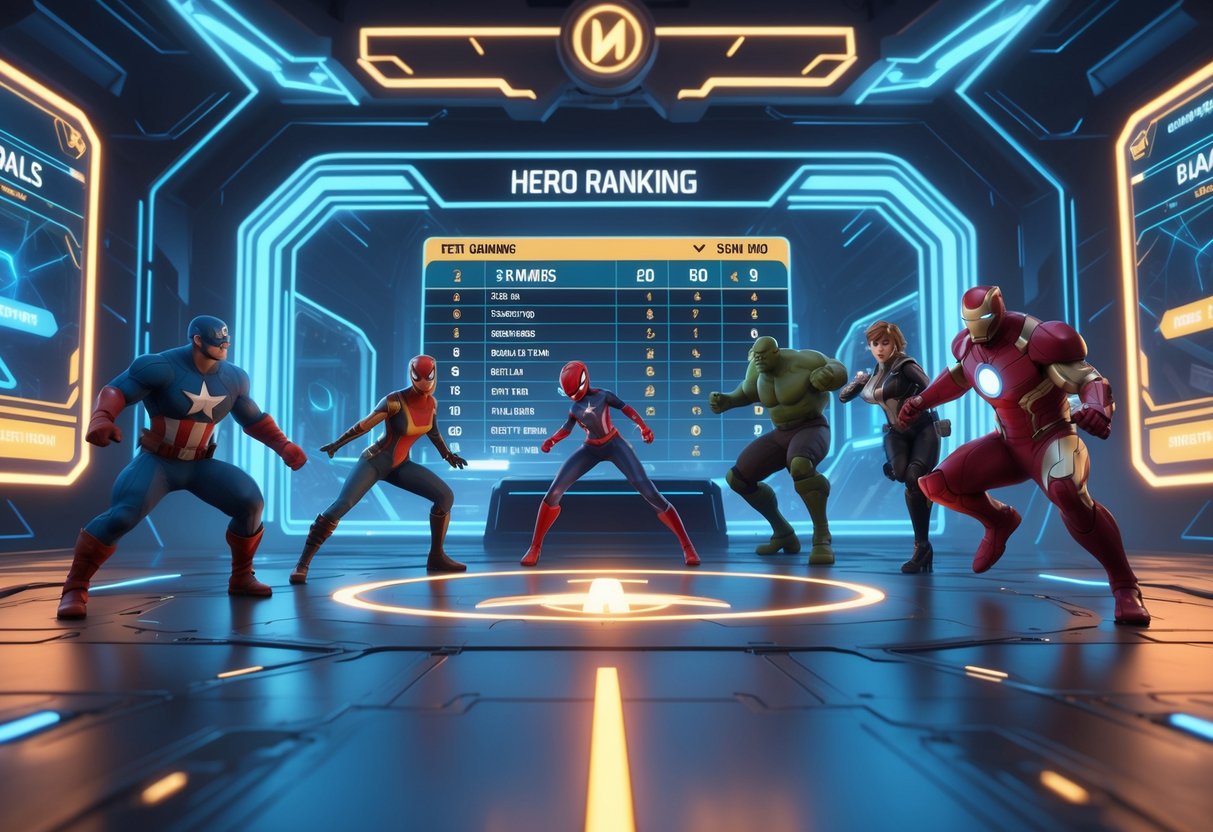
Climbing the Marvel Rivals ladder takes smart hero picks, adapting to meta shifts, and sharpening your skills. The trick is to master a few heroes but stay ready to counter whatever’s popular.
Adapting to Meta Shifts
The meta changes all the time—balance patches and new heroes keep things fresh. You’ve got to keep tabs on which heroes are hot in your rank.
S-tier heroes like Rocket Raccoon, Magik, and Mantis are crushing it right now. But they get banned a ton, so you can’t always rely on them.
A-tier heroes are usually better for consistent climbing. Picks like Peni Parker, Ultron, and Luna Snow perform well without being banned constantly.
Keep an eye on weekly tier lists and patch notes. When things shift, you’ve got to switch it up, not just stick with old favorites.
Quick win: Use community tier lists as a guide, but focus on heroes with low ban rates in your games. It’s better to have a strong A-tier pick you can actually play than an S-tier hero who’s always banned.
Team-up combos really matter for win rates. Ragnarok Rebirth with Thor and Hela, for example, gives Thor a 22% win bump. Learning these combos gives you a real edge.
Understanding Your Preferred Roles
Every role needs a different approach if you want to carry and climb. Figure out how your main role makes the biggest impact.
Vanguard players should focus on making space and keeping teammates safe. Dive tanks like Captain America and Magik are great for hunting strategists. Defensive tanks like Peni Parker can lock down areas and stop dives.
Duelist players need to pump out damage and pick the right targets. Iron Man with Ultron is a top choice. Flying duelists like Storm are great if you can get them, but bans make them risky.
Strategist players can swing fights the most. Rocket Raccoon’s ult is game-changing. Mantis with Guardian Revival is super strong, but not enough people use it.
Warning: Don’t try to play every role while climbing. Stick to one or two—knowing your positioning, cooldowns, and matchups inside out helps way more.
Flexibility matters later, but mastering your main role is the fastest way up the ranks early on.
Mastering a Select Pool of Heroes
Learn 2-3 heroes per main role instead of trying to play everyone. You’ll build muscle memory and better game sense that way.
Pick heroes that cover different situations:
- One meta pick for when it’s not banned
- One counter-pick for common enemy comps
- One comfort pick that fits your style
If you’re a strategist main, maybe that’s Rocket Raccoon (meta), Luna Snow (reliable), and Cloak & Dagger (comfort).
Practice in Quick Play until you really get their timing and positioning. Every hero has spots where they shine—and places they just don’t.
Team-up knowledge is key for your hero pool. Know which teammates boost your strengths and talk about it during hero select.
Track your win rates over 20+ games. If you’re struggling with a hero after all that, maybe swap them for someone else who fits you better.
Top players usually have a signature hero or two they’re amazing at, not just mediocre results across the board.
Tier List Metrics: Win Rates, Pick Rates, and Synergy
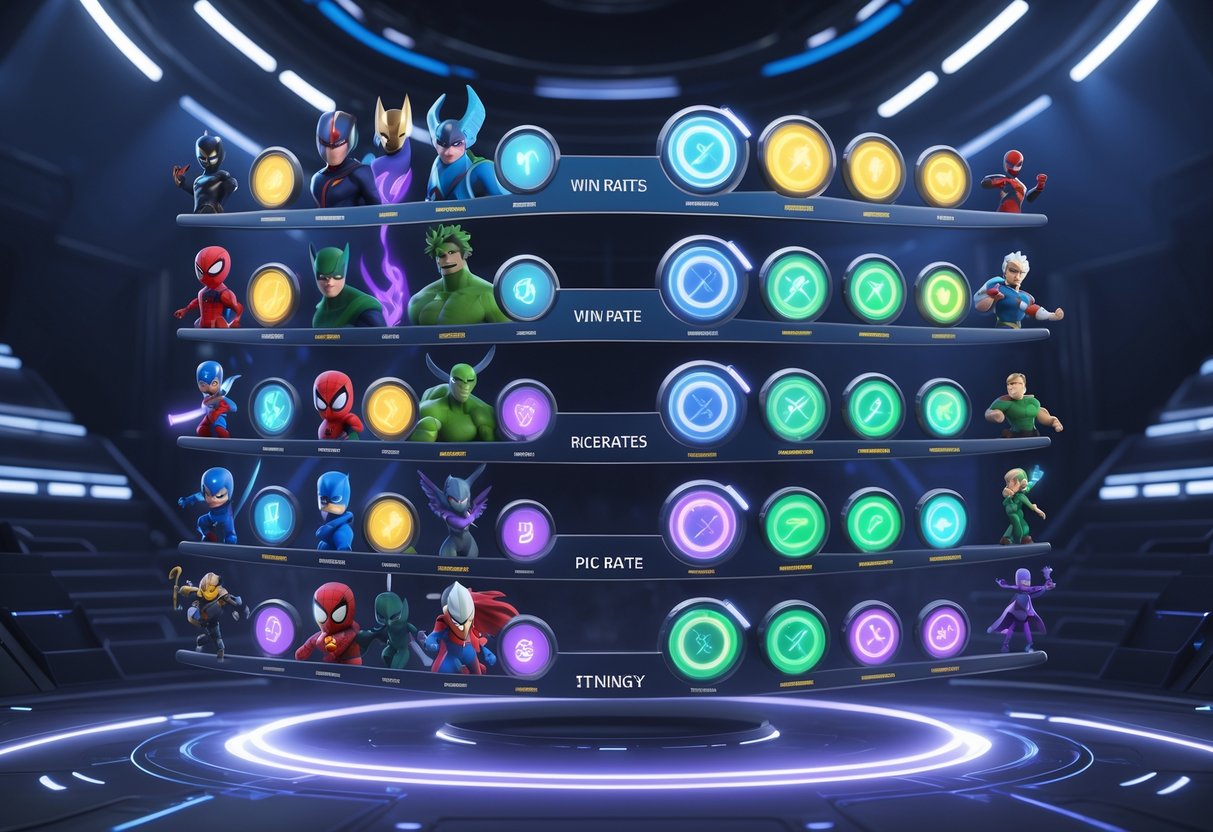
Modern tier lists use weighted scoring systems that mix several data points for accurate rankings. Team-ups and synergy really shake things up, while live data keeps lists fresh as the meta evolves.
Understanding Weighted Scoring Systems
We look at three main stats for tier lists. Win rate tells us who’s actually winning matches—it’s the clearest sign of a hero’s power.
Pick rate shows which heroes people trust in competitive games. High pick rates usually mean a hero’s strong, but sometimes it’s just hype.
Ban rate tells us which heroes scare people. If everyone’s banning a hero, they’re probably dominating or countering something popular.
The scoring algorithm weighs these stats by importance. Win rate matters most, then ban rate, then pick rate.
We also break down data by rank. A hero that’s great in Bronze might flop in Diamond because the skill requirements change.
Game mode matters, too. Quick Play and Competitive have different trends, but Competitive gives the best info for serious players.
The Significance of Synergy in Team-Ups
Team-ups can boost a hero’s performance way beyond their base stats. We track these combos separately because they can flip tier rankings.
Luna Snow’s a great example. Her healing gets way better with certain damage dealers thanks to team-up bonuses.
Team synergy actually impacts win rate more than solo hero strength sometimes. A B-tier hero can become S-tier with the right teammate.
We dig into team comp data to see who unlocks who. Some heroes don’t look great alone but become monsters in the right pairings.
Pick rate stats show that experienced players often pick for synergy, not just individual power. This shakes up the tiers in unexpected ways.
Tracking team-ups uncovers hidden meta trends. Some heroes seem weak solo but dominate when their synergy partner’s available.
Data-Driven Changes to Rankings
We update rankings every day, pulling in fresh match data from all competitive ranks. This helps tier lists actually reflect the latest balance changes and shifting strategies.
You can track hero viability across seasons and see how much things change. Season 3.5 data looks wildly different from what we saw back in Season 1.
Balance patches shake up the rankings almost instantly. We watch win rates for a couple of days after any update to catch these swings early.
Players adapt more slowly. New strategies take some time to develop, so tier movements can be gradual but still pretty significant.
We split data by rank brackets since hero effectiveness just isn’t the same everywhere. Diamond players get different results than Gold players, even with the same heroes.
Quick win: Check a few tier lists each week. Sites use different metrics, so comparing them gives you a better idea of what’s actually strong right now.
Most Popular and Effective Team-Ups
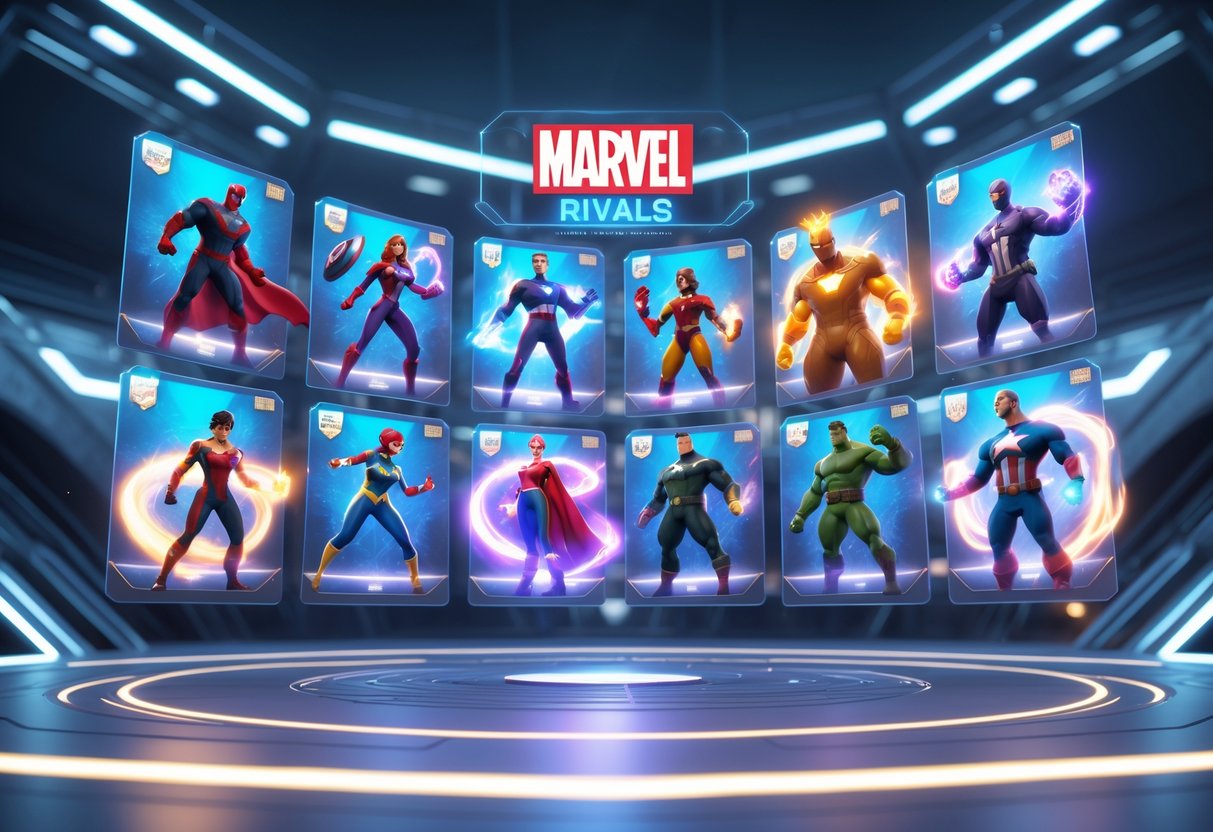
Team-Ups in Marvel Rivals can totally swing your competitive matches. Combinations like Fantastic Four and Gamma Charge are dominating the meta at the moment.
The best team-ups either boost core abilities passively or unlock active skills that can flip fights at the perfect moment.
Top Meta Team Combinations
S-Tier Team-Ups are running the show right now. The Fantastic Four combo stands out as one of the most reliable picks. This team-up gives Invisible Woman extra healing and tosses some bonus HP to teammates.
Primal Flame pairs Wolverine and Phoenix for some wild synergy. Phoenix gets a damage anchor bonus, and Wolverine’s leap starts burning for more damage. Tanks don’t stand a chance against this combo.
Gamma Charge still packs a punch even after recent changes. Hulk gets more base HP, while Namor picks up his gamma squid ability. Iron Man’s removal didn’t really hurt this team-up’s power.
Rocket Network brings a ton of utility with Peni Parker and Rocket Raccoon. Peni gets a second Spider-Nest that drops armor packs, and Rocket’s revive station upgrades itself with webs and mines for extra protection.
| Team-Up | Heroes | Key Benefits |
|---|---|---|
| Fantastic Four | Mr Fantastic, Thing, Invisible Woman | Enhanced healing, extra HP |
| Primal Flame | Wolverine, Phoenix | Burn damage, anchor bonus |
| Gamma Charge | Hulk, Namor | Extra HP, gamma squid |
| Rocket Network | Peni Parker, Rocket, Star-Lord | Utility deployment, teleporter |
Synergy Highlights: Pairing Heroes for Maximum Impact
The best team comps balance roles while activating strong team-ups. Invisible Woman shines as the anchor in Fantastic Four setups. Her S-tier healing just gets better with the team-up buffs.
Magneto pairs with Psylocke for Mental Projection. This A-tier duo spawns decoy copies, confusing enemies and making escapes easier in hectic fights.
Doctor Strange isn’t in any top-tier team-ups right now, so he’s not a meta staple. Still, he can pull his weight in teams that don’t lean on synergies.
You’ll get the most out of team-ups by spreading out your roles. Running two DPS for Primal Flame can work, but you’ll lose flexibility elsewhere. Most winning teams pick one strong team-up and stick with it.
Quick win: Master one S-tier team-up before you branch out. It’s just more effective.
Countering Leading Meta Team-Ups
If you want to disrupt enemy team-ups, you’ll need smart targeting and good bans in draft. Banning Hulk can wipe out Gamma Charge, though it’s not quite as devastating as it used to be.
Counter-diving works against Primal Flame. Wolverine and Phoenix like to play aggressively, so keeping your distance and focusing fire can take away their power.
Namor is a great answer to dive-heavy teams. His kit punishes anyone who tries to force an engage, and he shuts down team-ups like Dimensional Shortcut.
When you’re up against Fantastic Four, target Invisible Woman first. Take out her healing, and the extra HP isn’t nearly as scary.
Warning: Don’t waste both bans on a single team-up. Most teams can pivot if they lose their favorite combo.
Draft bans should match the enemy’s hero pool. If you know they love a certain combo, target their comfort picks instead of just following the meta.
Challenging the Meta: Underrated and Niche Picks
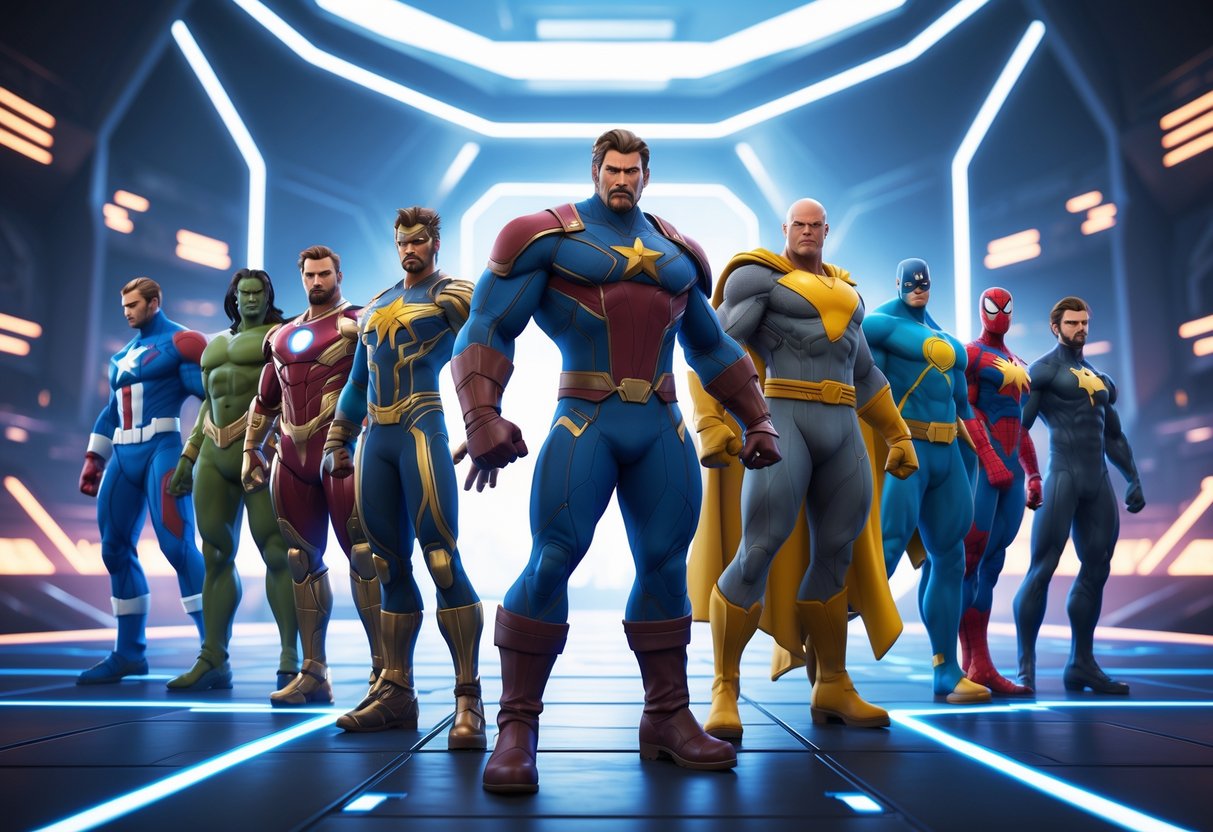
S-tier heroes might hog the spotlight, but a few underrated picks can really change a match if you use them right. Savvy players know when to bring out situational picks like Groot or Mister Fantastic to counter specific team comps.
Viable Situational Heroes for Competitive Play
Groot is worth a look, even though he’s C-tier. His barriers stop dive comps cold, especially against Magik-led teams.
If you use Groot’s wall well, you can split enemy strategists from their tanks. That opens the door for your DPS to snag some easy picks.
Venom thrives against slow, immobile teams. He can skip past frontlines and harass supports in the back.
Venom’s vertical mobility lets him dodge Peni Parker’s webs. His ultimate can break up grouped enemies hiding behind shields.
The Punisher isn’t great in high ranks, but he wrecks uncoordinated teams. His long-range shots punish anyone out of position.
Punisher’s hitscan keeps flying heroes honest. Pair him with Luna Snow for extra damage from her buffs.
Hidden Gems: B and C Tier Standouts
Mister Fantastic brings unique value in B-tier. He’s flexible enough to fill multiple roles in a match.
His stretchy attacks are great for checking flying DPS. Mister Fantastic can reach high ground spots that other heroes just can’t.
Adam Warlock offers strong team utility with his revive skills. His cocoon can rescue overextended allies from certain death.
Adam Warlock’s healing helps against burst-heavy teams. If you time his ultimate right, you can flip a fight on its head.
Star-Lord works best with a team that follows up on his mobility. He needs tanks to help him get value from his damage.
His jet boots make flanks possible. Star-Lord’s ultimate creates area denial when enemies bunch up.
When to Pick Niche Heroes
Pick Groot if you’re facing dive comps with Captain America and Magik. His barriers mess up their engages.
Go with Mantis over top strategists if your team has Star-Lord. Their Guardian team-up actually bumps win rates.
Grab Venom to break static defenses. His movement ignores Peni Parker’s webs and puts pressure on slow backlines.
Warning: Don’t pick niche heroes if your team can’t coordinate. These picks really need backup.
Think about the map too. Groot shines on maps with tight chokepoints, but he struggles in open spaces.
Quick win: Stick with one niche hero and master them. It’s way better than being average on several.
Updates and Future Changes in Marvel Rivals Competitive Scene
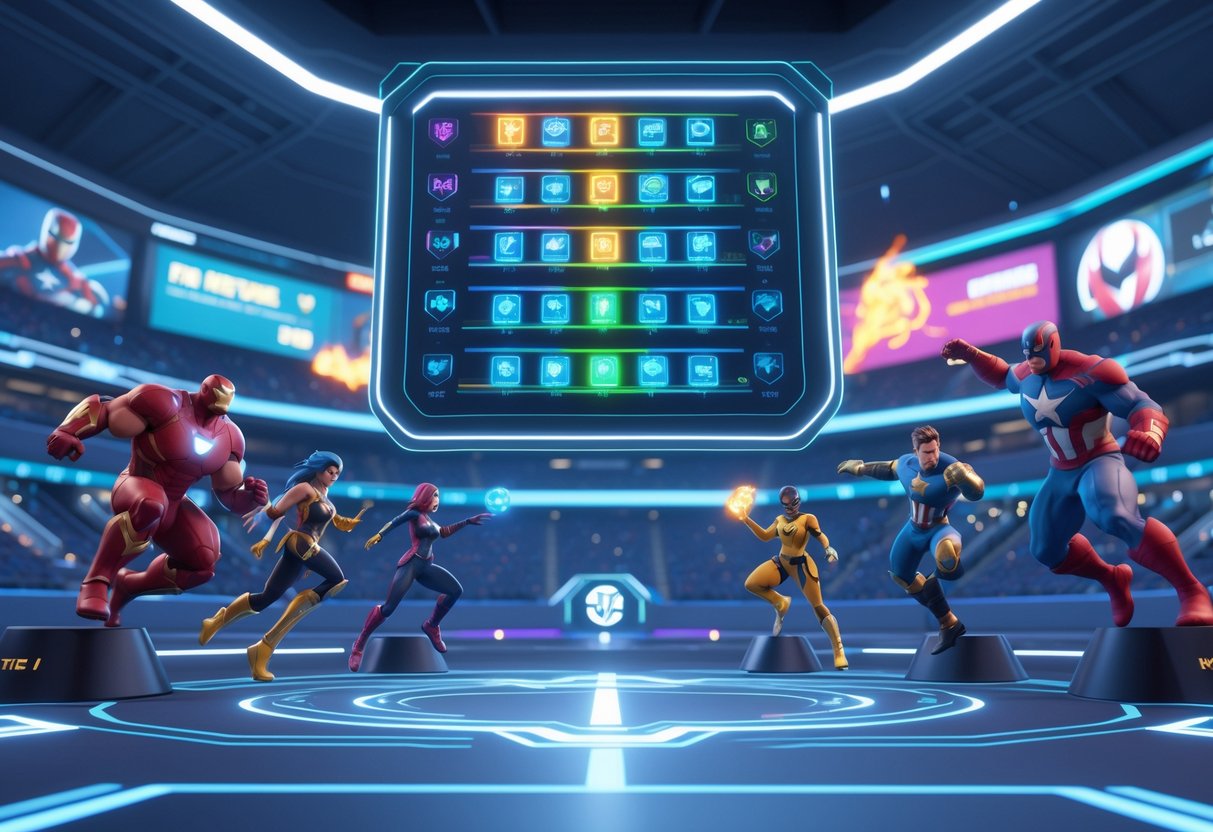
Season 3.5 is about to shake up the meta in a big way. Blade is joining the roster, and team-up changes look set to change hero performance across all ranks.
Anticipated Hero Buffs and Nerfs
NetEase keeps tweaking the meta with regular patches. The August 21 update hit seven heroes with some pretty important fixes.
Human Torch got a serious upgrade. He can now anchor team-ups and launch The Thing for big area damage. That makes him a lot scarier in team fights.
The Thing picked up new mobility options. His Human Torch partnership lets him fly, which fixes his old vertical map problems.
Spider-Man, Phoenix, and Black Widow all got bug fixes—not direct buffs, but they’re more reliable now. Phoenix’s ultimate no longer tanks her frame rate.
Rocket Raccoon and Cloak & Dagger both got technical fixes, so their abilities work as intended during clutch plays.
Season 3.5 should bring bigger balance changes. Early leaks hint at overhauls for several team-up mechanics.
Potential New Additions to the Roster
Blade is the big new hero for Season 3.5. He’ll probably shake up the tank or damage dealer meta, but we’ll have to see.
The Fantastic Four got “First Steps” skins in the newest patch. That might mean more heroes from their lineup are coming soon.
NetEase has been pretty consistent with releases. Season 2 brought Emma Frost and some big competitive changes back in April 2025.
New heroes almost always mess with the tier list after launch. Blade’s kit is still a mystery, but vampire powers probably mean high mobility or self-healing.
Map additions usually come with new heroes. Season 2 gave us Krakoa, and another new battleground is on the way for Season 3.5.
The devs are watching esports closely now. Hero releases take pro play into account, not just casual fun.
Frequently Asked Questions
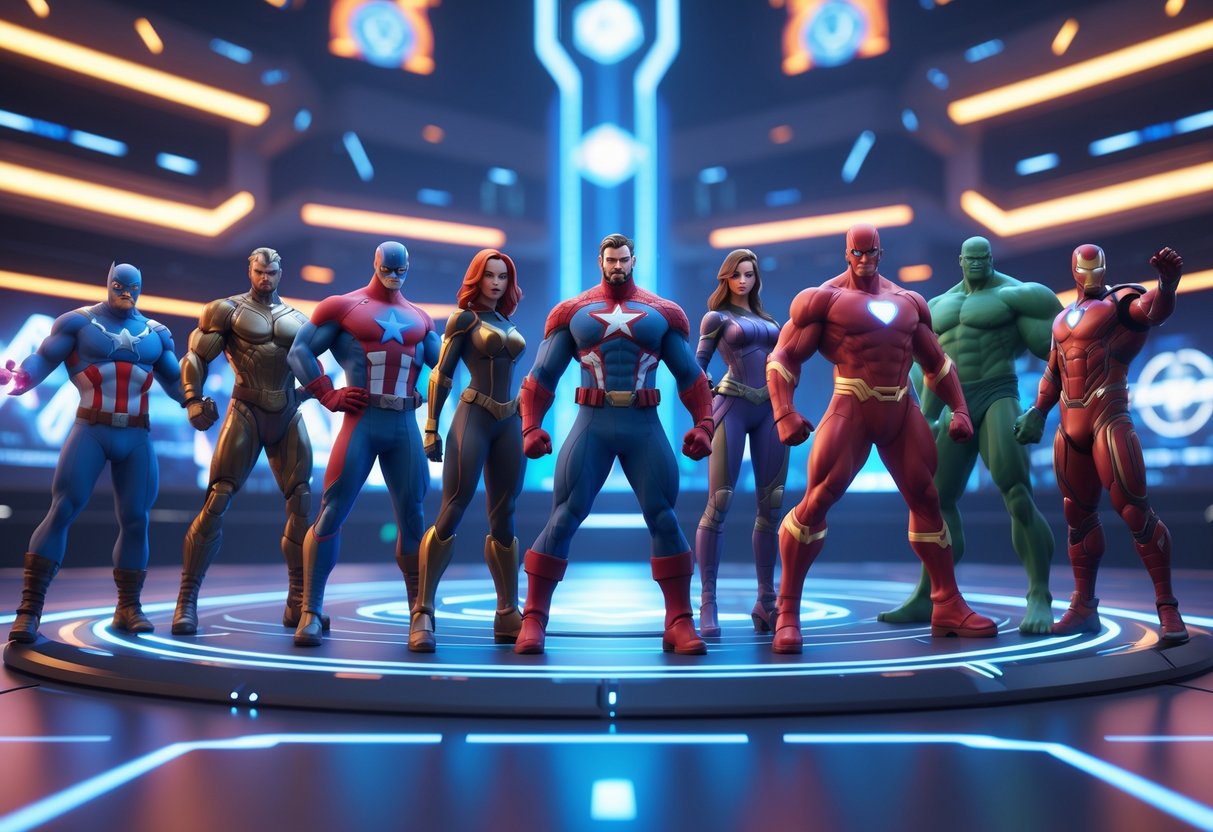
The Marvel Rivals competitive scene leaves a lot of players wondering about hero picks and meta strategies. People want to know who’s at the top and how to actually build a winning team.
Who are the top-tier characters in the current Marvel Rivals meta?
Rocket Raccoon, Magik, and Mantis are the S-tier heroes for Season 3. These three really shape the meta with their performance in every rank.
Rocket Raccoon is the top strategist, with great utility and team-ups. His synergy with Peni Parker is one of the best in the game.
Magik jumped to S-tier thanks to her burst damage and ability to pick off strategists. She’s a must-have for dive comps.
Mantis is up there too after recent buffs. She’s now the highest-scoring strategist, though her Guardian Revival team-up is still kind of slept on.
What are the rankings for DPS characters in the latest Marvel Rivals season?
Iron Man leads the DPS pack in A-tier with steady damage and strong team-ups. His Stark Protocol pairing with Ultron bumps win rates by 17%.
Storm is in B-tier but can be really strong if she avoids bans. The Jeff-Nado team-up is a big advantage for Storm mains.
Phoenix slipped a bit from earlier seasons but still puts up good numbers in high-tier lobbies. She’s a lot more effective in Celestial+ games.
Black Panther sits in B-tier as a solid dive pick. He works well with Captain America and Magik in aggressive comps.
Which characters have recently moved up in the competitive tier list for Marvel Rivals?
Luna Snow is one of Season 3’s biggest surprises, climbing to A-tier. Her new team-up with Hawkeye looks promising, and her stats are up across the board.
Magik made the biggest jump, going from lower tiers to S-tier. Dive comps are back, and her burst fits perfectly.
Ultron is holding strong in A-tier after a hot start. His hybrid DPS-strategist role is great for triple strategist teams.
Thor is steady in A-tier after his 2.5 rework. The Ragnarok Rebirth team-up with Loki boosts his win rate by 22%.
Where can I find the most up-to-date competitive tier list for Marvel Rivals?
Sites like U.GG and BoostRoyal post data-driven tier lists with regular updates. They use win rates, pick rates, and ban rates to rank heroes.
You’ll also find community lists on Reddit and Discord, but those are more opinion-based.
Pro esports analysts usually release weekly meta reports during active seasons. These break down hero performance by skill bracket.
Quick win: Check several sources and compare how they calculate rankings. You’ll get the best info by mixing stats with expert analysis.
Are there any underdog characters in Marvel Rivals that perform surprisingly well in competitive play?
Mister Fantastic lands in B-tier, but honestly, most players just ignore him. Still, he’s surprisingly flexible at different ranges and can really mess with flying teams if you know what you’re doing.
Adam Warlock shows up in B-tier as well. If you actually take the time to learn his kit, he can bring a ton of value to your team, though he’s definitely trickier to play than some of the other strategists.
Namor also hangs out in B-tier. In the right hands, he can be devastating—his area denial and damage output catch a lot of people off guard.
Warning: You’ll probably need to put in some extra practice with these characters if you want to unlock their full potential. They’re not as easy to pick up as the top-tier choices.
How does character selection affect team strategy in Marvel Rivals competitive matches?
Team-ups really shake up how compositions work in Marvel Rivals.
If you focus on heroes with strong synergies, you can bump your win rate by 15-20% or more. That’s not a small number!
Dive comps built around Captain America, Magik, and Black Panther push for coordinated aggression. These teams go after key targets fast, but they can fall apart against well-defended setups.
Flying comps with Storm and Iron Man force opponents to rethink their positioning and who they’re focusing on. Ground-based teams usually have a rough time dealing with aerial threats.
Counter-picking matters a lot at higher ranks. Heroes like Emma Frost and Peni Parker give dive strategies a hard time, and Magneto can really disrupt flying comps.
Quick win: Try to learn at least one hero from each tier. That way, you’ll stay flexible against all kinds of team comps and enemy tactics.

